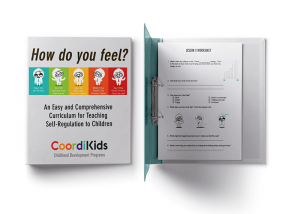Help for School and Kindy
Teaching Emotional Regulation Skills – A Teacher’s Best Tool
A couple of weeks ago, we released our brand-new curriculum for Teaching Emotional Regulation Skills to Students.
I’d like to take the opportunity this week to highlight one of our course: CoordiKids Classroom Course. And I’d like to highlight how it is designed to aid teachers in their admirable task of providing a well-rounded, focused education to our children! There are many benefits of the Classroom Course.
As a teacher, we know you want the best for your students. And, it can be quite difficult to meet every curriculum standard at a quick pace while giving enough attention to individuals along the way.
So, if you have students who struggle with self-regulation, your job can be near impossible!
The Classroom Course exercises are all about encouraging students with targeted movements. These targeted movements are to help them focus, concentrate and feel refreshed throughout their day.
The exercise movements are designed by our team of pediatric occupational therapists. Furthermore, these exercises are packed into videos that run for 5-10 minutes and are super easy to access. So, students can simply follow along as part of the regular classroom schedule.
Our goal was to provide teachers with a simple activity, with “plug-and-play” capabilities, that won’t cause them undue additional preparation time.
At CoordiKids, we might be known for our specialist work in sensory, fine, and gross motor skill development, but children at all levels benefit from movement breaks.
How Movement Breaks Can Improve Self-Regulation & Behavior in the Classroom
Movement breaks have been shown to help increase concentration and focus. Also, they have been shown to increase the efficiency of learning in general.
5 minutes of movement between lessons can make a huge impact in your student’s attention and behavior.
Movement breaks also allow students a chance to regulate or interrupt any anxiety or stress.
If you think that our elementary and middle school aged children are too young for anxiety and stress, think again. We talk about common struggles of starting school here, in our article When Your Child is Struggling.
You see, throughout early childhood, kids are still learning how to manage their behavior and emotions. Self-regulation is critical for learning and for social interactions. Following directions, sitting still without blurting out or having emotional outburst at every turn are all correlated with one’s ability to self-regulate.
Exercise in general has a positive effect on emotional regulation of both children and adults. Moreover, the specific exercises used in this type of class-wide occupational therapy movement breaks like the Classroom Course target the brain-body connections that aid children in physically being able to regulate their emotions better.

Self-Regulation Activities for Kids
Specifically, vestibular stimulation movements have been scientifically shown to improve self-regulation of emotions. (Vestibular stimulation movements have also been shown to improve coordination, balance, and focus on tasks).
Vestibular stimulation activities target the vestibular system in the inner ear. And they are among the best type of self regulation activities for kids.
The vestibular system is triggered with head movements. A common example of this type of movement is bending over at the waist and straightening back up again.
So, anything that moves the head in drastically different directions. That’s why the Classroom Course program includes several vestibular movements as self regulation activities for kids.
What is the Classroom Course?
Designed by our team of pediatric occupational therapists, the exercises of the Classroom Course are packed into videos that run for 5-10 minutes. So, students can simply follow along as part of their regular classroom schedule.
Teachers play the Classroom Course videos once a day. Each video takes approximately five to ten minutes to complete, and exercises may be reinforced throughout the day as necessary.
Many of the exercises complement or parallel the self regulation activities for kids offered in the CoordiKids “How Do You Feel” curriculum for Teaching Emotional Regulation Skills to students.
With a new set of exercises available every week for 30 weeks, the Classroom Course covers a full school year, providing consistent and progressive learning!
But, Does it Really Work?
We are always fine-tuning our programs based on feedback from you, the teachers. But, after our initial launch of the program with students ranging in age from 8-11 years, this is what the teachers utilizing the program for the first time had to say about using the Classroom Course:
Teacher 1:
“At the beginning some Grade 4 students refused to participate, by the end of a week, all children took part. Within 2 weeks, the course became an important part of the day.”
Teacher 2:
“Students were much more settled and attentive following CoordiKids. A very worthwhile program.”
Teacher 3:
“I found CoordiKids especially beneficial before reading groups for Year 4 students.”
Teacher 4:
“I use CoordiKids at least once every day, but more and as often as the time table permits!”
Teacher 5:
“I use the Classroom Course twice per day. It helps students to re-focus during a 2-hour learning block. The Grade 6’s enjoyed the exercises!”
Teacher 6:
“I use the Classroom Course twice per day if possible. I definitely observe my class working a lot more quiet and settled for the duration of the morning.” (Year 6 class)
In Summary:
The teachers, as a group, reported that after a 5-minute Classroom Course movement break they observed a 90% – 100% reduction in:
- the number of children fidgeting,
- children in need of repeated instructions,
- children in need of re-direction to sit still and to stop talking, and
- in children re-directed to stay on task.
Furthermore:
After using CoordiKids, 80% of teachers were able to identify children with motor skill and balance challenges.
(Note: These children can now be referred for further intervention to help with functioning and learning.)
And this, from a Year 5 student:
‘Before CoordiClass I found it hard to think of words to use in my writing but after the 5-minute Classroom Course movement break, it was much easier to write.’
Are you interested in trying the Classroom Course of self regulation activities for kids in your classroom? It can easily be used as part of your plan for teaching emotional regulation skills to your students.
